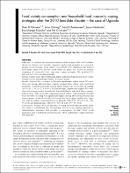Food variety consumption and household food insecurity coping strategies after the 2010 landslide disaster : the case of Uganda

View/
Date
2016-06-09Author
Rukundo, Peter M
Oshaug, Arne
Andreassen, Bård A
Kikafunda, Joyce
Rukooko, Byaruhanga
Iversen, Per O
Metadata
Show full item recordAbstract
To evaluate the nutritional situation of the victims of the 2010 landslide disaster in Uganda, food varieties consumed and coping strategies were assessed.
Design
Cross-sectional. Food variety scores (FVS) were obtained as the total of food items eaten over the last week while an index was based on severity weighting of household food insecurity coping strategies. We included 545 affected and 533 control households.
Setting
Victims in the affected Bududa district in Eastern Uganda and those victims resettled in the Kiryandongo district, Western Uganda.
Results
Adjusted for covariates, in Bududa significantly higher mean FVS were observed among: affected than controls; farmers than others; and relief food recipients. Control households scored higher means (SE) on severity of coping: 28·6 (1·3) v. 19·2 (1·2; P<0·01). In Kiryandongo, significantly higher FVS were observed among: control households; household heads educated above primary school; those with assets that complement food source; and recipients of relief food. Severity of coping was significantly higher among affected households and non-recipients of relief food. Affected households had a higher likelihood to skip a day without eating a household meal in Bududa (OR=2·31; 95 % CI 1·62, 3·29; P<0·01) and Kiryandongo (OR=1·77; 95 % CI 1·23, 2·57; P<0·01).
Conclusions
Whereas FVS and severity of coping showed opposite trends in the two districts, resettlement into Kiryandongo led to severe coping experiences. Administrative measures that provide a combination of relief food, social protection and resettlement integration may offset undesirable coping strategies affecting diet.
URI
https://doi.org/10.1017/S1368980016001397https://kyuspace.kyu.ac.ug/xmlui/handle/20.500.12504/753
